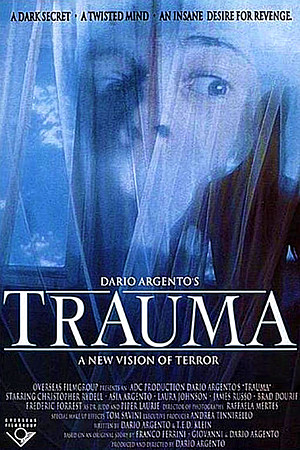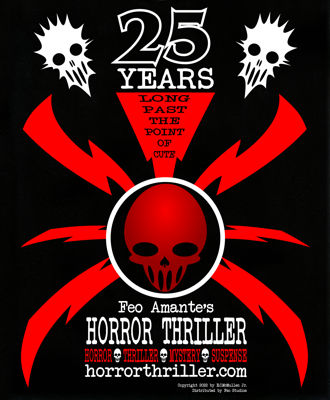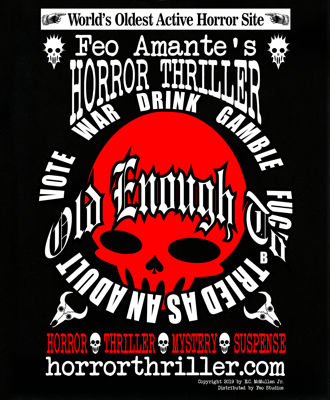 |
 |
Review by Max Glaessner |
|

TRAUMA- 1993USA Release: April 20, 1994 ADC Films / Overseas FilmGroup Rated: Argentina, Germany, UK : 18 / Australia: MA / Finland: K-18 / Italy: VM14 / USA: R |
|||
When contemplating the work of Argento, a lot of groundbreaking films come to mind. However, chances are that TRAUMA isn't one of them.
Released in the United States in 1993, TRAUMA is one Argento flick that people just can't seem to agree on. Some folks, like me for example, happen to like it a lot, whereas others would probably tend to lump it with the rest of his "uninspired" 90's output, alongside such cinematic miscalculations like THE CARD PLAYER, or DO YOU LIKE HITCHCOCK? Subsequently, it's really no surprise that Anchor Bay decided to release TRAUMA alongside these 2 films in their "5 Films by Dario Argento Collection".
Back on the subject of this review, however, I was particularly excited upon receiving the Argento collection, to find that TRAUMA was included in the mix. Reason being, I think that TRAUMA is a massively underrated Argento picture that hasn't been given it's due. At best, it's a giallo picture for an American audience, utilizing the suspense and surrealist techniques that made his earlier work famous, while still infusing more or less of a linear American plot. At worst, it's an American box office failure, that audiences probably couldn't relate to because they had to actually pay attention, for once.
Story wise, TRAUMA begins with standard Argento fare. A female doctor opens up the door to a mysterious black-gloved patient, who, removing an electric wire noose from his/her briefcase, proceeds to decapitate the terrified doctor. As usual, we see everything from the point of view of the person with the black gloves, so we have no idea who this person is. Cut to the next scene.
Here enters our girl in great peril, Aura Petrescu (Asia Argento: THE STENDHAL SYNDROME, PHANTOM OF THE OPERA [1998], LAND OF THE DEAD) who is spotted by a motorist, David Parsons (Christopher Rydell: DR. RAGE) as she attempts to jump from a bridge. Startled, David emerges from his truck and half negotiates / half forces her into the safety of his vehicle. After saving her, he takes her out to a restaurant for lunch where we discover two things: firstly, that Aura is a run away, and second, that she is anorexic. After running to the bathroom to vomit the little bit of food that she ate at the table, she emerges from the restaurant, just to be nabbed by two officers in a youth services vehicle.
As it happens, Aura has been on the run from a mental hospital where she was confined at the wishes of her mother, Adriana Petrescu (Piper Laurie: CARRIE, THE FACULTY) with whom Aura shares a rather unhealthy relationship.
The Petrescus are a Romanian family, and from the moment Aura is ushered back into her home by the police, we notice a rather eerie quality that hangs over the house. The mother Adriana is a practicing psychic/medium, and dresses in long flowing black garments. She doesn't order Aura to go back to the hospital, but from what we can observe, she rules the household in a rather fierce but subtle manner. This kind of performance is effortless for Piper Laurie, as we are all so used to seeing her as a ruthless, menacing mom. Even Aura's father (Dominique Serrand) seems somewhat fearful around her mother. Watching him tip toe around, one gets the impression that he fears for the emotional and mental stability of his wife, perhaps even at the expense of his daughter.
On the night of Aura's arrival at home, Adriana is holding a séance. Typical to Argento's style, there is zero explanation as to why a séance is being held, but the members of the Romanian community show up at the house in droves, dressed head to toe in black and ready to conjure the dead. Outside it begins to storm as Aura's mother and her friends sit around a table, hands locked in communion with the spirit world.
Whether or not early nineties audiences considered this sort of thing to be "too cheesy" (or too abstract for that matter), this remains a very dark and unsettling scene. As the thunder and lightning build to a crescendo, Adriana announces in a booming otherworldly voice, "I KNOW WHO THE KILLER IS." The killer, as we can infer, is the same head-hunter who decapitated the doctor at the very beginning of the movie. In the midst of all the guests that flee this very creepy séance, Adriana takes off running across the backyard into the darkness and the rain, while her husband follows suit.
In concern for her beloved mother, Aura calls out to her from her bedroom window in pure terror, then pursues her mom and dad into the deep brush behind their house where she discovers a nasty surprise.
In horror and grief, Aura flees back to David, the man who was kind enough to offer her help. Seeing as he just happens to be a profile artist for the News agency that is covering the continued head hunter murders, David spends the remainder of the film helping Aura to solve the identity of the person who murdered her parents. In the process of doing so, he falls in love with the girl, and the more he discovers about her and her strange family, the more personal the murders appear to be.
The beheadings continue, and the victims with the exception of Aura's folks, seem to be made up entirely of doctors and nurses. One tortured, miserable doctor we meet briefly is played by Brad Dourif (CHILD'S PLAY [all], THE EXORCIST III, DEATH MACHINE, ALIEN RESURRECTION, URBAN LEGENDS, THE LORD OF THE RINGS: THE TWO TOWERS, PULSE, Rob Zombie's HALLOWEEN), but he meets his end in an elevator shaft in a scene somewhat reminiscent of DEEP RED. As David and Aura dig closer and closer to the truth, they end up putting themselves (and their own two heads) at risk.
What people immediately tend to jump on, in relation to TRAUMA, is that the movie doesn't seem to know what it is.
Sure enough, Argento's American debut does tend to seem more Italian than American at times. The choice of Hopkins, Minnesota as a city in which to set the film was about as random of a choice as any, and didn't supply the movie with any particularly recognizable landmarks.
Similarly, the whole Transylvanian community within Minnesota was unknown to me prior to seeing this movie, although Argento has insisted upon this as his inspiration for the Romanian slant. Furthermore, a lot of folks have argued that Aura's anorexia nervosa as a theme in the movie made very little sense, although I would contend that it serves a very specific function, particularly in highlighting the dependent relationship between Aura and her mother.
Take into consideration that anorexia nervosa is a very American problem, and the fact that there weren't many films addressing the subject in the early nineties, and I think there are some compelling reasons for the inclusion of this disorder within the film.
In addition to this, there are a number of subtleties that may only be absorbed upon watching this movie for a second or third time, (particularly David’s past of drug abuse, which was unlike the anorexia nervosa, rather poorly hinted at).
Also mysterious was the short reggae music sequence that takes the film into the outro at the very end. Reggae was very hot at the time, so Argento probably embraced this little addition as a way of attracting audiences with a cultural fad. Unfortunately, it just came off as avant-garde and weird, so Americans didn’t get it.
Overall, I think the film would have been more accepted in the US, if Argento had cut his own European sensibilities right out of the mix, but instead he gave us fusion of a horror/thriller with heavy giallo overtones. There is a beginning, middle, and an end to this story, but with the experimental qualities and unexplained characters, some people just got frustrated.
For example, a lot of viewers are kind of perplexed and annoyed by the little nerd boy who lives next-door to the Petrescu house and spies with his binoculars, citing his character and the role he fulfills as particularly random. However I tend to see this geeky kid as the most legitimately American presence in the movie. The little boy almost seems more at home in a Ray Bradbury tale than one of Argento’s. The scene in which his mother scolds him for his wild imagination is indicative of all our childhood fears. What if it wasn’t just his over active thirteen-year-old brain? What if he did really see a head in the window next door?
One more complaint that is often lodged against TRAUMA is that there wasn't enough gore in this movie, at least not as much as we're used to seeing in Argento's past endeavors.
I think that there is little validity in this criticism, as first of all, Argento is not really known as a straight-up gore director, he is more into delivering scenes of stylistic violence, a point on which TRAUMA certainly delivers.
Secondly, it should be pointed out that Tom Savini (DAWN OF THE DEAD, DAY OF THE DEAD, INNOCENT BLOOD, FROM DUSK TILL DAWN, DAWN OF THE DEAD [2004], LAND OF THE DEAD, GRINDHOUSE, PLANET TERROR) was hired to do all of the special effects on this film, and while he did an amazing job producing the severed heads, some of the more violent effects he created were edited out.
For instance, at the beginning of the film, Savini himself was supposed to be accidentally decapitated on the street, which would therefore trigger the trauma inside the mind of the headhunter killer. It can only be assumed that amazing scenes like this ended up on the cutting room floor because Argento was once again considering the American audience and how much graphic violence they would be willing to tolerate.
If this film was not quite violent enough, we have the board of censors to thank for that, but on the contrary, I think that most of the executions in this film were handled well, and any fan of the macabre beauty behind Argento’s death scenes should be pleased. Some of the images in this movie are so realistic looking, that it puts the current state of special effects to shame (again, please note the severed heads).
A movie like TRAUMA wouldn't be made today without the help of CGI, and we know how different that would look.
All in all, Dario Argento's TRAUMA straddles a thin line between a lucid giallo nightmare and an American horror thriller. In the end, one could say that the film succeeds at being neither, or if you are of my mindset, you may find that the film reflects a little bit of both. No matter how you end up feeling about it, this movie is worth a look, if for no other reason, because it is an example of Argento’s unique aesthetic when applied to a more conventional audience. Though it’s hit or miss at points, I think it will be remembered in the future, particularly by Argento’s truest fans, as a hell of an attempt.
I give it four shriek girls.




This review copyright 2008 E.C.McMullen Jr.

|
| DRESS NICE | |
FEO AMANTE'S HORROR THRILLERCreated by:E.C.McMullen Jr. FOLLOW ME @ |
| Amazon |
| ECMJr |
| Feo Blog |
| IMDb |
| Stage32 |
| X |
| YouTube |
| Zazzle Shop |

